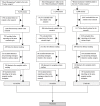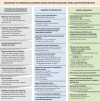Therapeutic options to minimize allogeneic blood transfusions and their adverse effects in cardiac surgery: a systematic review
- PMID: 25714216
- PMCID: PMC4408825
- DOI: 10.5935/1678-9741.20140114
Therapeutic options to minimize allogeneic blood transfusions and their adverse effects in cardiac surgery: a systematic review
Abstract
Introduction: Allogeneic blood is an exhaustible therapeutic resource. New evidence indicates that blood consumption is excessive and that donations have decreased, resulting in reduced blood supplies worldwide. Blood transfusions are associated with increased morbidity and mortality, as well as higher hospital costs. This makes it necessary to seek out new treatment options. Such options exist but are still virtually unknown and are rarely utilized.
Objective: To gather and describe in a systematic, objective, and practical way all clinical and surgical strategies as effective therapeutic options to minimize or avoid allogeneic blood transfusions and their adverse effects in surgical cardiac patients.
Methods: A bibliographic search was conducted using the MeSH term "Blood Transfusion" and the terms "Cardiac Surgery" and "Blood Management." Studies with titles not directly related to this research or that did not contain information related to it in their abstracts as well as older studies reporting on the same strategies were not included.
Results: Treating anemia and thrombocytopenia, suspending anticoagulants and antiplatelet agents, reducing routine phlebotomies, utilizing less traumatic surgical techniques with moderate hypothermia and hypotension, meticulous hemostasis, use of topical and systemic hemostatic agents, acute normovolemic hemodilution, cell salvage, anemia tolerance (supplementary oxygen and normothermia), as well as various other therapeutic options have proved to be effective strategies for reducing allogeneic blood transfusions.
Conclusion: There are a number of clinical and surgical strategies that can be used to optimize erythrocyte mass and coagulation status, minimize blood loss, and improve anemia tolerance. In order to decrease the consumption of blood components, diminish morbidity and mortality, and reduce hospital costs, these treatment strategies should be incorporated into medical practice worldwide.
Introdução: O sangue alogênico é um recurso terapêutico esgotável. Novas evidências demonstram um consumo excessivo de sangue e uma diminuição das doações, resultando em estoques de sangue reduzidos em todo o mundo. As transfusões de sangue estão relacionadas a aumento na morbimortalidade e maiores custos hospitalares. Deste modo, torna-se necessário procurar outras opções de tratamento. Estas alternativas existem, porém são pouco conhecidas e raramente utilizadas.
Objetivo: Reunir e descrever de maneira sistemática, objetiva e prática todas as estratégias clínicas e cirúrgicas, como opções terapêuticas eficazes para minimizar ou evitar transfusões de sangue alogênico e seus efeitos adversos nos pacientes submetidos à cirurgia cardíaca.
Métodos: Foi efetuada uma pesquisa bibliográfica com busca ao descritor “Blood transfusion” (MeSH) e aos termos “Cardiac surgery” e “Blood management”. Estudos com títulos não relacionados diretamente ao tema da pesquisa, estudos que não continham nos resumos dados relacionados à pesquisa, estudos mais antigos que relataram estratégias repetidas foram excluídos.
Resultados: Tratar anemia e plaquetopenia, suspender anticoagulantes e antiplaquetários, reduzir flebotomias rotineiras, técnica cirúrgica menos traumática com hipotermia e hipotensão moderada, hemostasia meticulosa, uso de agentes hemostáticos sistêmicos e tópicos, hemodiluição normovolêmica aguda, recuperação sanguínea intraoperatória, tolerância à anemia (oxigênio suplementar e normotermia), bem como várias outras opções terapêuticas mostram ser estratégias eficazes em reduzir transfusões de sangue alogênico.
Conclusão: Existem múltiplas estratégias clínicas e cirúrgicas para otimizar a massa eritrocitária e o estado de coagulação, minimizar a perda de sangue e melhorar tolerância à anemia. Estes recursos terapêuticos deveriam ser incorporados à prática médica mundial, visando diminuir o consumo de hemocomponentes, reduzir a morbimortalidade e custos hospitalares.
Figures




References
-
- Bennett-Guerrero E, Zhao Y, O'Brien SM, Ferguson TB, Jr, Peterson ED, Gammie JS, et al. Variation in use of blood transfusion in coronary artery bypass graft surgery. JAMA. 2010;304(14):1568–1575. - PubMed
-
- Sojka BN, Sojka P. The blood donation experience: self-reported motives and obstacles for donating blood. Vox Sang. 2008;94(1):56–63. - PubMed
-
- Novaretti MCZ. Importância dos carreadores de oxigênio livre de células. Rev Bras Hematol Hemoterapia. 2007;29(4):394–405.
-
- Mackenzie CF, Shander A. What to do if no blood is available but the patient is bleeding? South Afr J Anaesth Analg. 2008;14(1):39–43.
-
- Koch CG, Li L, Duncan AI, Mihaljevic T, Cosgrove DM, Loop FD, et al. Morbidity and mortality risk associated with red blood cell and blood-component transfusion in isolated coronary artery bypass grafting. Crit Care Med. 2006;34(6):1608–1616. - PubMed
Publication types
MeSH terms
Substances
LinkOut - more resources
Full Text Sources
Other Literature Sources
Medical
